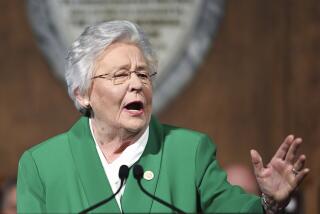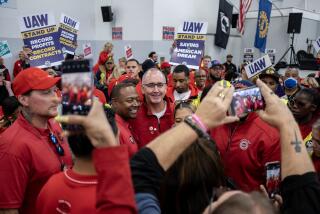What really caused the decline of American unions?
Evan Soltas, a Princeton student writing fluently from a platform at Bloomberg View, should be praised for touching off a vigorous debate among print journalists, bloggers and other commentators (including me) over the role of unions in the U.S. economy. As for the points heās raised and on which heās now doubling down in reaction to criticism heās received, theyāre still wrong.
Itās proper to remember that what really set off this discussion was the United Auto Workersā recent defeat in an organizing vote at the Volkswagen plant in Chattanooga, Tenn. In that vote the union wasnāt opposed by the company but by Republican political leaders across Tennessee, who threatened to destroy the plant by withdrawing public subsidies if the union won.
The vote was close, 53% to 47%. If 44 workers out of the more than 1,300 had voted differently, today weād be talking about a union breakthrough instead of the end of organized labor in America. The most penetrating and unsentimental analysis of the event comes from former union organizer Rich Yeselson, here and here.
Among other things, he observes that union organizing is hard no matter where you are, and certainly no easier in a traditionally anti-union region, in a factory where the treatment of workers is pretty good, and by a union that has allowed itself to give too much back to management in other plants as part of its effort to preserve the domestic auto industry.
Back to Soltas. His original piece is here. It lucidly outlines his view that unions are finished in the U.S. and thatās OK because their effect on workers was mostly bad. Hereās my response (negative), along with those from union advocate Michael Wasser, Mother Jones blogger Kevin Drum and Matt Bruenig of Demos. Soltas claims that UC Berkeley economist Brad DeLong agrees with him, but I havenāt found anything DeLongās written that validates that claim; the DeLong post Soltas links to doesnāt show it. Frankly, Iād be surprised if Soltas were correct. But I live for surprises.
Soltas published a response to me and some of the other commentators last week. Before addressing his specific points, let me say that heās shown his debating skills by smoothly misstating my argument and putting words in my mouth. But that wonāt wash.
For example, he asserts that I wrote that the decline of unions in the U.S. is āprimarily the result of public policies that undermine labor or increased employer hostility.ā He complains that I called him āhopelessly naiveā for thinking that āeconomics explains the decline of unions.ā
I wrote nothing of the kind. I wrote that āone simply canāt explain the decline of union representation without acknowledging the role of employer opposition and its empowerment by government policyā--not that those were āprimarilyā the reason. And I called him āhopelessly naiveā for asserting that federal labor law has had ālittle to doā with union decline.
Now he cites, among other items, a paper from Barry Hirsch of Georgia State acknowledging the role of āstrong management opposition, a less favorable labor law environment [and] high levels of unfair labor practicesā in declining union membership. We can debate over how big a role these things play, but to assert that they have ālittle to doā with the trend is, well, hopelessly naive.
Soltasā bedrock argument is that global economic competition is sufficient to explain the decline of unions in the U.S. A couple of problems with that, pointed out by several commentators. One is that unions remain strong, certainly much stronger than in the U.S., in many other industrialized countries, such as Germany, France and Canada. Donāt their workers face global economic competition too?
The other problem is that we can match the decline of unions quite closely to one particularly union-hostile federal law: the Taft-Hartley Act of 1947. Taft-Hartley placed draconian restrictions on union activities, including picketing and strikes, and gave the green light to state right-to-work laws that barred union shops. Soltas dates the decline in union membership to the 1960s and ā70s, but a graph he presents in his own post (reproduced above), plainly shows that it began in the 1950s--that is, right after the Taft-Hartley Act. To think this legislation had ālittleā to do with the decline in unions is, well, hopelessly naive.
Soltasā other main point is that there are plenty of ways to achieve progressive economic policies benefiting the working class, without unions. āWe have to look for other ways to build employee bargaining power,ā he writes. OK ... but what? He doesnāt identify any. By definition, anything that builds employee bargaining power will have to be some form of concerted action--in other words, a union.
Soltas observes that Americaās second-largest anti-poverty program, the earned income tax credit, was after all āborn in a de-unionized America.ā Not really. The EITC was born in the early 1970s, when union membership among non-agricultural workers in the private sector was still just under 30%, not far below its peak of about 35%. Today membership is closer to 12%. Does he really think the ground is as nourishing for the EITC today as it was then? And Soltas fails to mention that the largest U.S. anti-poverty program, Social Security, was born when union membership was very much on the rise, and the barriers to organizing were coming down very quickly.
One final point. Soltas plainly resents my dismissing his reliance on academic studies of labor effects and macroeconomics in making his case. (I said his argument shows the ālimitations of textbook learning.ā) His final comeback to me consists of a couple of macro charts that I donāt recognize, having learned my economics in the gutter. But they seem to depict a world with two economic inputs and one output, or maybe one input and two outputs, as though thatās how labor relations and politics work in the real world.
Anyone who thinks that the real world resembles a chart with one straight line intersecting two other straight lines, and who claims that he can nail his argument by āwriting out a macroeconomic model for this,ā needs to get out more.
More to Read
Sign up for Essential California
The most important California stories and recommendations in your inbox every morning.
You may occasionally receive promotional content from the Los Angeles Times.











